The Swedish Lenten bun is mostly known as a semla — or semlor in plural.
You may know it by its other, more sinister name: Kingslayer.
“Fat Tuesday should be prohibited and the Lenten bun forcibly expelled from Sweden, as it has committed regicide”.
At least that’s what poet Johan Gabriel Oxenstierna penned in his diary in 1771 after Swedish king Adolf Fredrik succumbed after a meal of semlor.
In defense of the poor bun, the king had also dined on sauerkraut, turnips, caviar, smoked herring, and champagne. A royal meal, indeed.

What do you want to know about semlor?
This is a beast of a post that spans over 4,400 words. You can just click here to go straight to the recipe.
Here’s a table of contents so it’s easier for you to navigate:
Semlor are a big thing in Sweden
Ever since the unfortunate passing of the monarch, semlor seem to inspire deep dedication, if not outright fanaticism. How about a blog dedicated to reviewing semlor? A thesis or two treating semlor? Or even a society for semlor?
Among the literary examples, we have a childhood favorite, the lisping detective Ture Sventon who eats “temlor” all year around. Of course, solving tricky heists performed by your arch-nemesis is easier with a tin full of semlor to munch on.
On Fat Tuesday, the Swedes buy around 5 million semlor — and who knows how many are baked at home. If you want to ingest a substantial share of calories in one coffee break, look no further than a big semla. But a warning is in place. As you understand, this innocent-looking delicatessen is neither for the feeble-hearted nor for the weak-stomached. Please proceed with caution.
Eager to test your bravery (or your stomach’s)?
By all means, skip ahead to the recipe that will show you how to make the perfect Swedish semla.
The history of semlor
You’re already familiar with the most note-worthy part of the history of semlor: the death of king Adolf Fredrik in 1771. But how did it end up on his table?
The Swedish Lenten bun’s German roots
As with many other things, Sweden likely “borrowed” the concept of semlor from a similar tradition in Germany.
But, let’s start with the name. In fact, the Swedish Lenten bun has several names — hetvägg (or hetwegg), fastlagsbulle, fettisdagsbulle, and semla. Today, the name semla is the most popular, but traditionally, the dish was known as hetvägg.
According to food historian Jan-Öjvind Swahn, the name “semla” has its origin in the German word semel or semele, which comes from the Latin simila, referring to fine wheat flour. From the late 16th century, semla referred to a plain wheat bun, which was “small like tomatoes and weighed at least four lod (53 g)”.
The oldest mention in Swedish literature of hetvägg is in a wedding poem from 1689. Hetvägg comes from the German Heisswecken. According to baker Carl-Bertil Widell, the original heisswecken were small breads shaped like crosses and flavored with cumin. Rich families of the Hanseatic league would sometimes serve heisswecken at breakfast, where the bread would be hollowed and bread’s crumbs cooked with a little bit of butter and maybe cream or sugar before it was placed back in the bun. This made the dry bun more enjoyable.
So, the reason for the different names is simple: a semla was just a plain bun. Instead, hetvägg was a dish where a filled bun was eaten with warm milk.

Celebrating Fat tuesday in Sweden
So why do we eat this filled bun in Sweden?
Fat Tuesday, or Fettisdagen, was the last “fat” day before the period of Lent before Easter. During Lent, people would abstain from certain kinds of food. So, the day before Lent (always a Tuesday) got a special treatment.
So, what did people eat on this last day to indulge before Easter? As always, you celebrate with what you have and what you’re familiar with. According to Louise Hagberg, on Öland, people ate kroppkakor, a type of pork-filled potato dumpling. In other places, people feasted on brown beans with pork, or pigs’ feet, or lutfisk, or a thick pork pancake. In Kivik in Skåne, they’re even said to have eaten a type of dolphin.
Ethnologist Nils-Arvid Bringéus notes that in some places in Sweden, Fat Tuesday was known as pannkaketisdag, Pancake Tuesday. That is similar to how the day is celebrated in other parts of the world, with Shrove Tuesday.
But the day was also known as “white Tuesday”, and white foods such as wheat bread and milk were popular. The semla fits pretty nicely — white, and a true fatty feast. Bringéus suggests that semlor started to spread in southern and mid-parts of Sweden during the 18th century. So why not in the Northern parts? Simply because they rarely grew wheat.
Semlor also required expensive ingredients like almonds and sugar, making it a dish for those who could afford some luxuries in their diet — like the king. In 1756, Christopher Manderström notes that some households will save milk for several days so they can serve hetvägg before Lent.
In fact, even the white, finely ground wheat flour was a rare ingredient in most households. This made it convenient to buy the fine white buns at a bakery instead of baking them yourself. Even Årstafrun, the noblewoman Märta Helena Rehnstierna, notes in her diary in 1816 that she went into town to buy “hetväggsbullar” to make semlor.

So when do you really eat semlor?
Yes, traditionally semlor have been served before Lent.
Nowadays, I’ve seen saffron semlor sold before Christmas. (And yes, Swedes seem to take pride in complaining about how early semlor can be found in the stores.) Normally, you start seeing them in bakeries and supermarkets at the beginning of the new year. But it hasn’t always been like that…
In 1952, a bakery apparently got fined for starting to sell semlor too early. The reason was not religious as much as a matter of precaution. In post-war Sweden, the costly ingredients required for semlor were not plentiful.
But times changed. Widell shares that already in the 1960s, semlor would appear after Twelfth Night, sold on Saturdays as well as Tuesdays. In the 70s, sales started on January 2nd, on all days of the week.
Bringéus suggests that the name evolved from fastlagsbulle (Lenten bun) to semla, as that name was less connected with Lent, making it easier to sell semlor for a long period of time.
Now, let’s amuse ourselves with a historical investigation covering the last 280 years of Swedish semlor.
The evolution of semlor
Even though we’ve reviewed the history of semlor, it may be difficult to understand exactly how much this little feast of a fancy cake has evolved during the years. My research in old cookbooks uncovered vastly different interpretations. So, let’s amuse ourselves with a historical investigation covering the last 280 years of Swedish semlor.
1737 – Christmas semla?
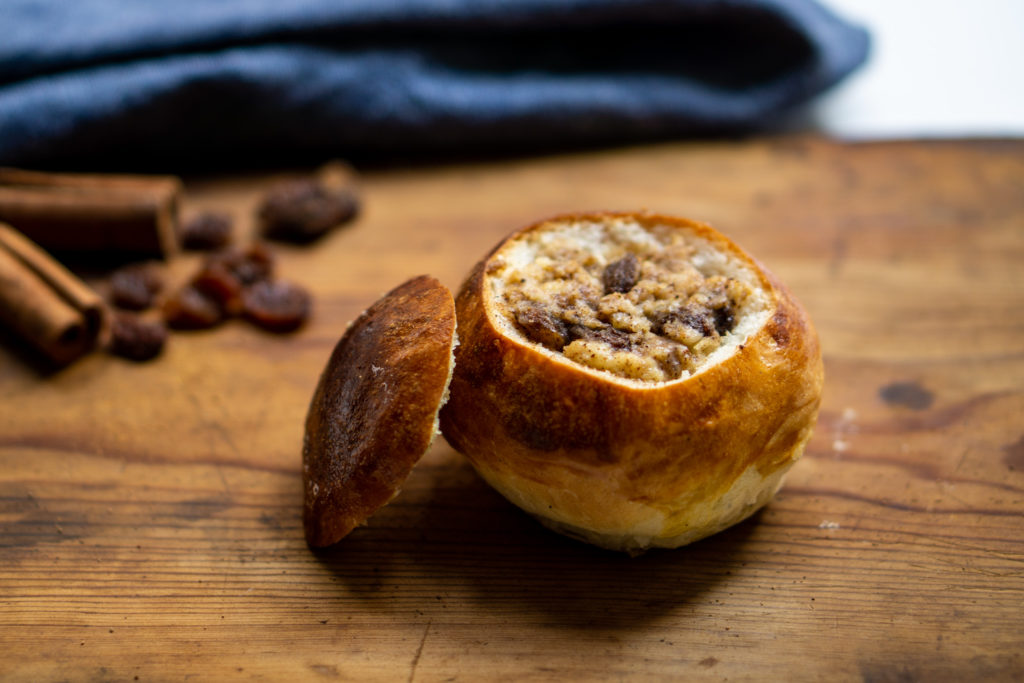
Susanna Egerin’s cookbook from 1737 shares the earliest recipe of a semla that I’ve found. Hollow out the bun and mix the crumbs with cream. Add flour to melted butter and let it brown, and then add a mix of raisins and currants, sugar and cinnamon. Mix this together with the wet crumbs, and fill the bun with the mix. Add back the lid, which you have fried in butter.
The verdict
I deciphered heavy gothic typography and cryptic instructions to bring you this. But the effort was worth it—all in all, this is a pleasant bun. The overall taste is far more buttery than in today’s semlor. Disregarding that currants and raisins feel strange to put in anything I’d call a semla, the result is rich and sweet. A winner, but definitely in a category of its own. It feels like a Christmas version of a semla.
1755 – Bun soup
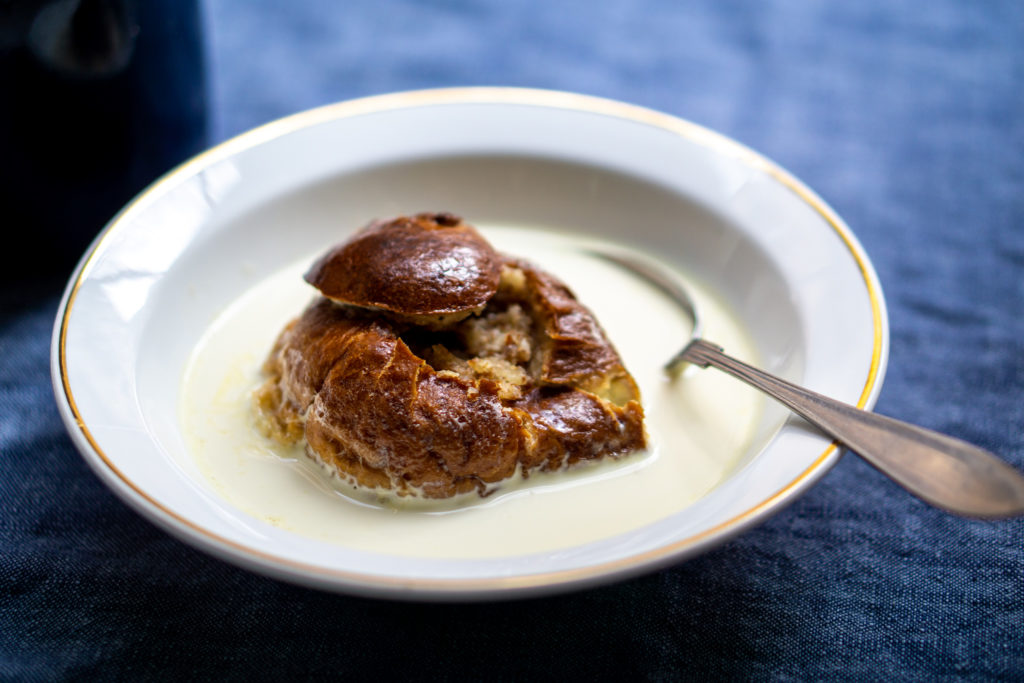
Cajsa Warg’s cookbook from 1755 is one of the most well-known historical cookbooks in Sweden. Unsurprisingly, this semla was listed in the section covering soups… You stuff the bun with its crumbs mixed with cream, grated almond, and sugar. Place the lid back, tie a string around it and let it simmer in warm milk for half an hour. For serving, add a “soup” of milk mixed with yolk.
The verdict
How would this even hold together after being steeped in milk for half an hour? I could almost hear Captain Picard getting the report “shields are at 10%!” as the buns were covered three quarters in milk. But lo and behold, Warg’s semlor didn’t disintegrate as much as expected. Flavour-wise, the poor filling fights an uphill battle against the soggy, milky bun mass.
If this is what king Adolf Fredrik ate before his untimely demise, it is not surprising if semlor sneakily contributed — it is a heavy dish, to say the least. And, it still is bun soup.
1847 – Plain Jane
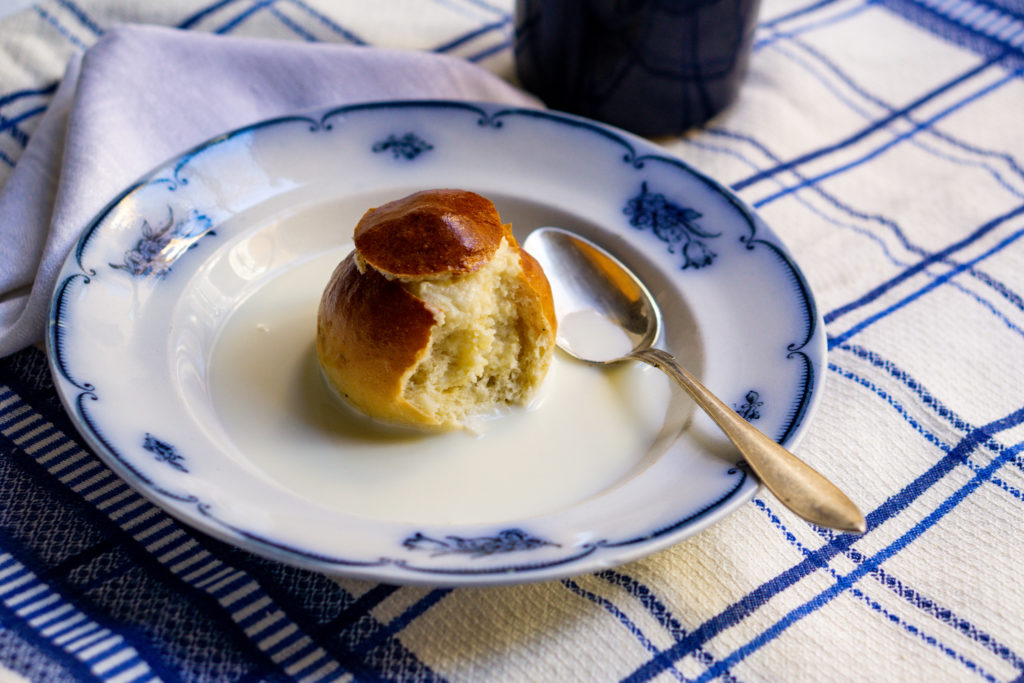
The semla in Gustafwa Björklund’s cookbook from 1847 is rather modern creation. The bun is filled with a mix of its own crumbs, cream, and almond paste. Add the lid and heat it gently in the oven before serving.
The verdict
Adored food writer Hiram sings the praises of Björklund’s semla. And no wonder why. This creation is the herald of the modern semla, with a filling that feels almost contemporary. Skip heating it and add some whipped cream instead, and no Swede would believe that the recipe is over 160 years old. The only con is that the creation feels a bit — no additional spices or even bitter almond to flavor the filling. Tasty, but we can do better.
1896 – Key lime pie semla
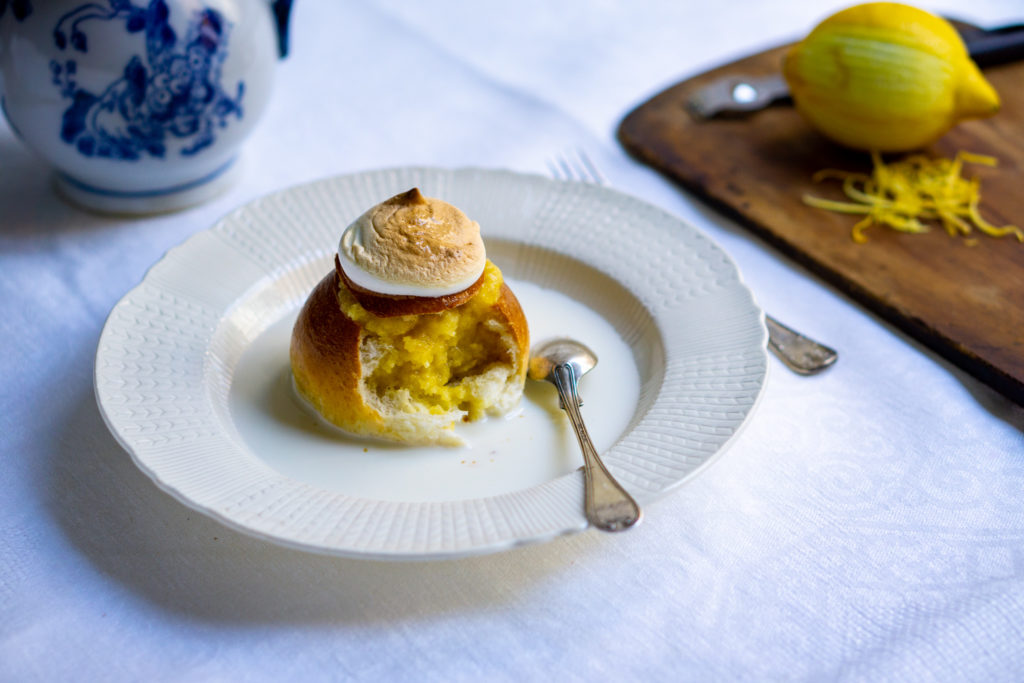
The second edition of Hagdahl’s cookbook from 1896 suggests an unusual semla. Fill a bun with the crumbs mixed with butter, yolk, lemon peel, almond paste, and sugar. Add some succade (candied lemon peel) on top of the filling and then place the lid back. Whisk egg whites and sugar to a meringue and pipe it on top of the lid. Let the meringue set with a hot iron rod, or more conveniently in modern times, with a kitchen torch or the oven’s grill setting.
The verdict
The yolk, butter, and lemon give the filling a beautiful yellow shade and a rich but still light flavor. If Susanna Egerin’s semla with currants and raisins was Christmas, this is spring. But is it still a semla, with candied lemon peel and the meringue on top? It not only tastes but looks different, more like a rustic predecessor of the key lime pie.
1926 – Introducing… whipped cream!
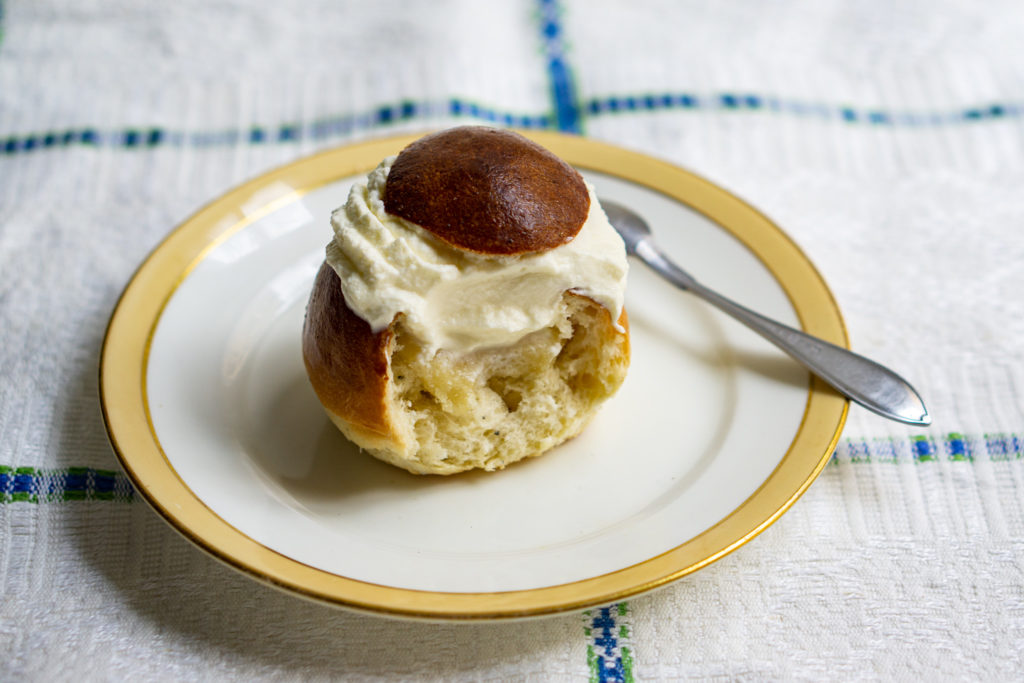
This recipe published in newspaper Svenska Dagbladet in 1926 seems to constitute a normal fin-de-siècle filling for a semla, with the almond paste sliced rather than stirred into a mixture. This is also the earliest recipe I’ve found that includes whipped cream. Whipped seems to have become increasingly common after the second world war. Hollow out the bun, add a thick slice of almond paste, some whipped cream on top, place the lid back.
The verdict
A fan of almond paste, I was prepared to worship this semla. But the generous slice feels unrefined, as it is heavy and doesn’t spread through the bun. You either get just bun or mostly almond paste, depending on how skillful and strategic you are as you sink your teeth into the sturdy creation. A step backward in the evolution of semlor, despite the whipped cream. It is tolerable, but not harmonious enough to tempt me.
1934 – The royal semla
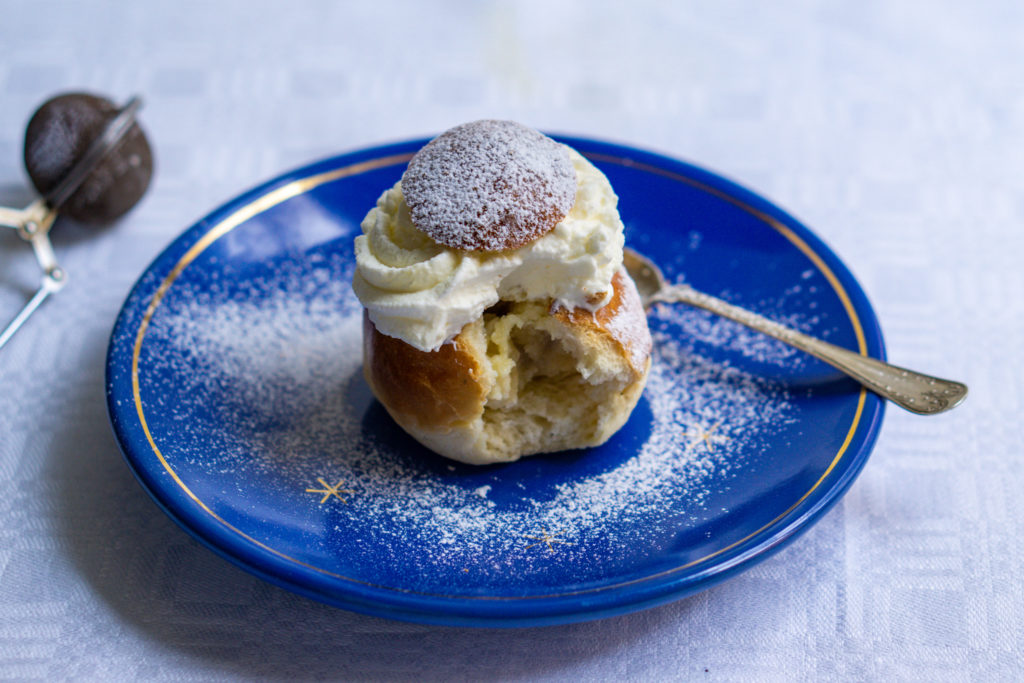
The princesses’ cookbook from 1934, written by Jenny Åkerström, presents a modern semla. Mix the bun’s crumbs with cream, almond paste made of 50% almonds and 50% sugar, and bitter almond. Fill the bun and add whipped cream on top. Dust the lid with icing sugar.
The verdict
This recipe is from 1934 is indeed a modern semla. The big difference from the approach in 2018 is not in the filling but in the bun itself. Jenny Åkerström suggests grating almonds and bitter almonds into the dough. This gave the bun a very nutty flavor, which is nice, but I’d rather add an extra dose of cardamom.
1943 – Wartime surrogates
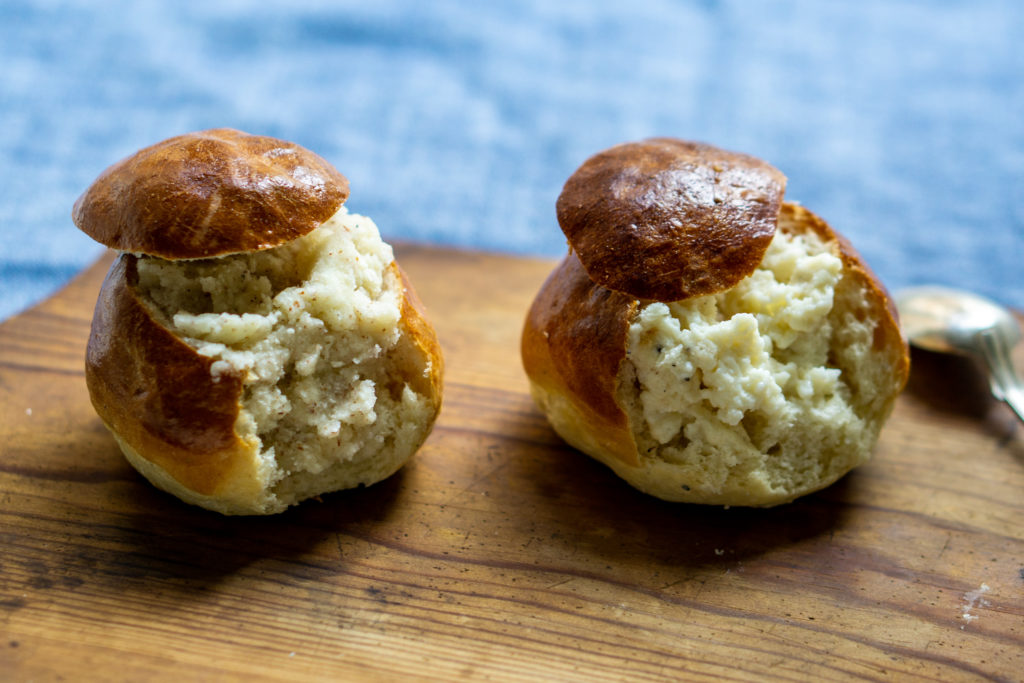
Sweden wasn’t directly participating in the second world war, but food restrictions and rationing were still part of everyday life. Two recipes in newspaper Svenska Dagbladet in 1943 suggest using either potato (left) or milk and gelatin (right) to make do with fewer almonds for the filling.
For the gelatin filling, hollow out the bun and add crumbs to warm milk mixed with gelatin, bitter almond essence, and sugar.
For the potato filling, grate boiled potato and mix it with milk or cream, sugar, vanilla, grated almonds, and bitter almond.
The verdict
The wartime versions likely tasted better than they should have. Butter instead of margarine, real eggs instead of a substitute (where can you even buy fake eggs made of milk protein nowadays?). But even neglecting that, these semlor barely passed the grade.
Despite using cream instead of milk, almonds instead of almond essence, and a good deal of sugar, the potato flavor dominated the other filling completely. The potato made the filling compact and the crumbs were omitted from the recipe, but using the crumbs would have resulted in a better, lighter filling.
The milk and gelatin mix could have turned into a semla pannacotta (interesting…) but was more an undefinable milky filling, like a baby purée.
1951 and 1954 – Variations on a theme
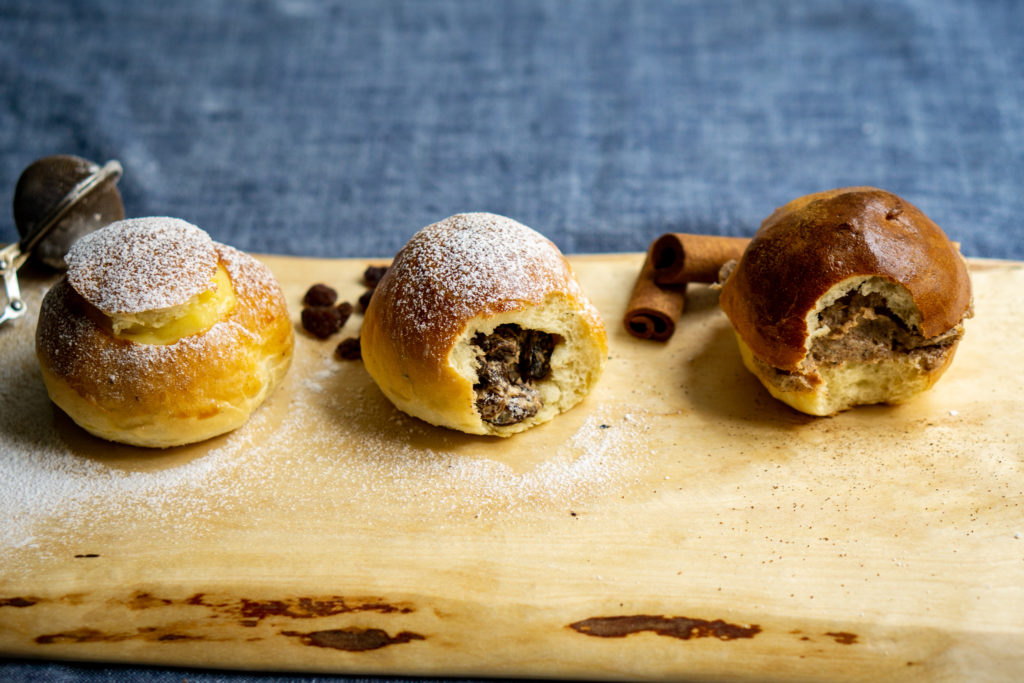
As the good household mistress apparently served semlor every Tuesday during Lent, recipes from Svenska Dagbladet suggests some variations. Sliced in half like a hamburger and spread with a mix of cinnamon, sugar, and butter. Custard. Or why not butter, cinnamon, and raisins, filling the bun from underneath so it looks untouched?
The verdict
The heated hamburger-shaped semla tasted like a cinnamon bun. Custard is always pleasant enough but just turns this into a “sun bun”, custard-filled bun. And the secret stash of raisins and butter? Not too bad — but what kind of creature is this, really? All in all, this trio skirts the border of still being semlor. I can see all of them presented as trendy new versions of semlor, but they don’t contribute much of interest and don’t provide an unforgettable experience.
2020 – The perfect semla?

In later years, degenerate species have cropped up at an alarming rate. Every café and bakery in Sweden seem intent on birthing a semla that will attract media attention and lure in hoards of customers. Most of them are hybrids of already winning concepts. Croissant and semla. Donut and semla. Even… princess cake and semla. Some more monstrous than others. Others take on popular flavors, such as chocolate, Nutella, or blueberry. But when it comes to classical semlor, we might have reached a peak in development. Can it get better?
This refined creature at the pinnacle of evolution has a light and airy bun, rich in cardamom. The filling of almond paste and crumbs is preferably flavored with cardamon and bitter almond. On top: whipped cream, the lid and a dash of icing sugar. Of course I am partial, but I ask again — can it get better?
Anatomy of a classic Swedish semla
In our quest for mild perfection, let’s study the anatomy of the classic Swedish semla of today.
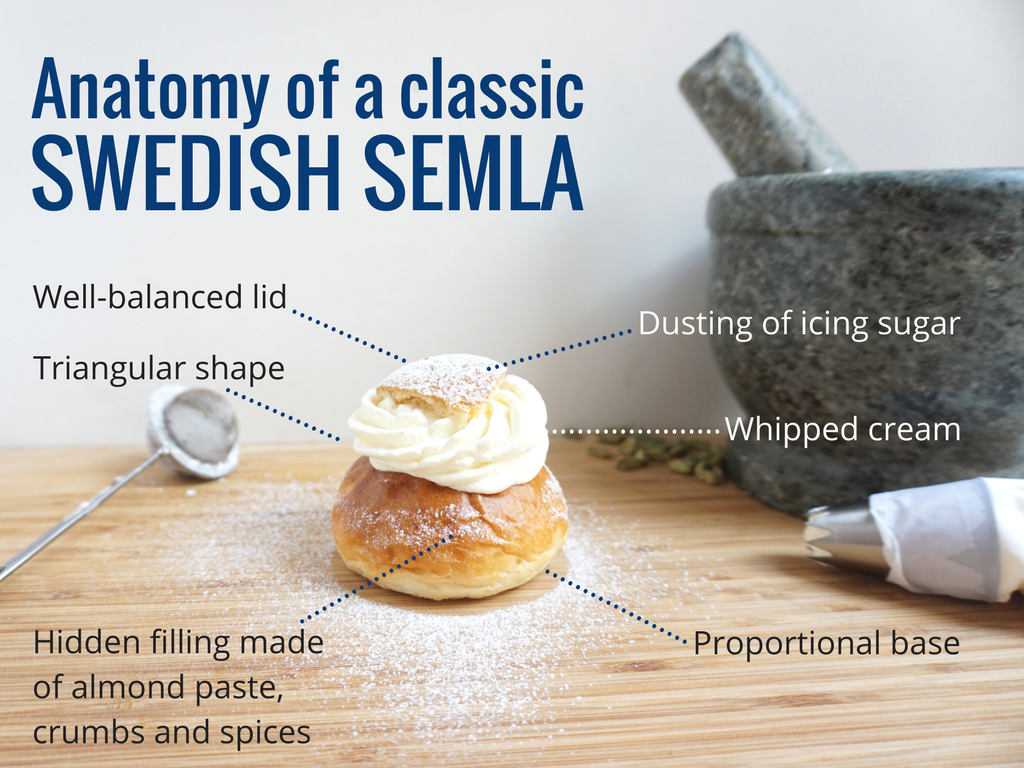
The base: a not-so-plain wheat bun
Older recipes don’t share dough recipes but instead say: “take a bun”. Helpful.
Once dough recipes do make an entrance, they call for melted butter (or even margarine, eh). But that isn’t the best approach, as melting the butter forces you to use more flour. Instead, I add butter at room temperature.
Hiram suggests adding hartshorn salt (baker’s ammonia) to the dough for an airier result. The tests with hartshorn salt and with baking powder produced a small difference compared to leaving it out. If you knead the dough well, you will get fluffy buns regardless. A lot of bakers at home add an egg to the dough to produce the same result.
Flavoring the dough
Jenny Åkerström flavors her dough with almonds and bitter almond. This is pleasant but not necessary. Most of the dough recipes shy away from using much cardamom. This is obviously a personal preference, but I go heavy with the cardamom — instead of the recommended 2 teaspoons I use a tablespoon. You can’t compare using ready-ground, half-ancient cardamom and buying whole cardamom that you grind just before using it. I know it adds an extra step, but the reward will be worth it.
Not too big, not to small…
Eating a semla doesn’t have turn you into a sluggish boa constrictor in food coma. Simply make the buns smaller.
Mattias Ljunggren, baker and author of a book on semlor (as well as creator of the wrap semla) suggests 30 grams for a mini-semla and 60 grams for a large. 60 grams turns into a small meal for me.
I tend to use around 45 or 50 grams of dough per bun, which turns into one clementine sized ready-baked bun. That size turns it into a good-sized treat but not a crazy feast. If you want more, just have another one.
Shaping the bun
Before you make any silly remarks about the shape of buns… these are important matters, so stop sniggering. If your semla is too flat, the proportions will look awkward.
To roll the perfect semla, press it down against a flat surface using your hand. Keep pressing, make small circular motions and gradually make your hand more cupped. Voilà — a beautiful, spherical semla.

The filling
For the filling, feel free to run amok with citrus peels and succade, like Hagdahl, or frying the bread filling with raisins and currents, like Egerin.
My experiments focused mostly on the more classic approach, with almond paste mixed with the crumbs from the bun. But what would bring out the best flavors?
Toasting the almonds.
Adding cardamom, or bitter almond, or lemon peel (not a fan).
Using more almond than the ordinary 50-50 split with sugar.
Blanching the almonds. Not blanching the almonds.
Using shop-bought almond paste.
On top of that, testing countless combinations of the above. But what would be the perfect flavor combination?
As frustrating as it is… the results of the experiments were inconclusive.
Believe me, that is not for lack of testing. However, there’s a limit to how much almond paste I can reasonably stomach and how much my unrefined palate can discern.
But let’s summarize the findings so you can use them to inspire your own mixture. Toasting the almonds became overpowering, so if you want to go down that route only toast a small proportion (1/5-1/4). To still get a nuttier flavor but with better balance, use more almonds than sugar or don’t blanche the almonds.
While shop-bought almond paste was smoother and brought out the oil from the almonds in a way you can’t at home, it was also lumpier and not nutty enough.
One of the best fillings had approximately 60% unblanched almonds to 40% sugar, a strong touch of cardamon and hints of bitter almond.
The concluding advice would be to do something according to your own taste and what you have at home. Almond paste is delicious, so it will taste good regardless.
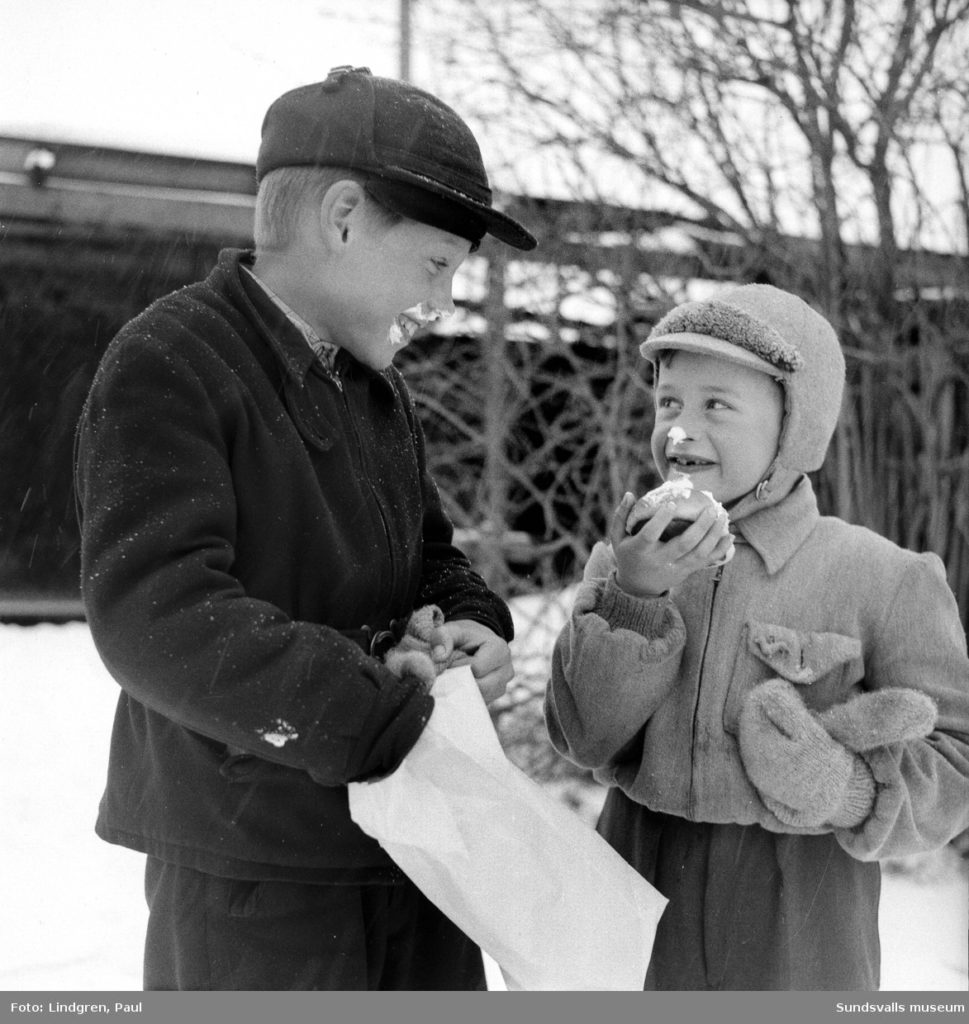
The cream: to pipe or not to pipe
If you want to add some flavor to the cream, sugar and maybe a hint of vanilla are the most common. Just don’t go overboard as the filling will be sweet enough as it is. A loosely whipped cream will encourage your lid to make a run for it and be trickier to eat. Aim for a firm whip, without venturing into grainy butter-territory.
I like to pipe the cream, but that’s just me being vain. Your semla will obviously be just as delicious regardless.
Presentation and serving
For the final part when making your Swedish Lenten bun — the assembly.
The lid
You can run wild with heart shapes, or stars, or what have you. But there are mainly two camps when it comes to lids — round or triangular.
I might be shallow, but the rounded lid is often an excuse for sloppiness. It is faster to just cut off the top of a semla than to carefully craft a neat triangular. Unsurprisingly, supermarket semlor sport round hats. The attention paid to the lid says something about the creator. But while I am firmly in the triangular party, the round lid does have a distinct advantage for big semlor. A larger cap can easier scoop up parts of the cream before you take a first real bite. Less whipped cream in your whiskers!
If you make the lid too big and consequently the hole in the bun too wide, you might end up with filling peaking out from under the cream. While this isn’t a catastrophe, it alters the look. “Semmelmannen” who dedicates his blog to reviewing semlor takes a similar view. He suggests that the most refined part of semlor might be that “the most sacred is hidden from view and only revealed to the one invited to a full love act”.
Whatever shape of lid you settle for, pay attention to the size. Larger than a fascinator and smaller than a sombrero, you want a confident and well-balanced headpiece for your semla. And please don’t cut it in the middle and turn it into a hamburger.
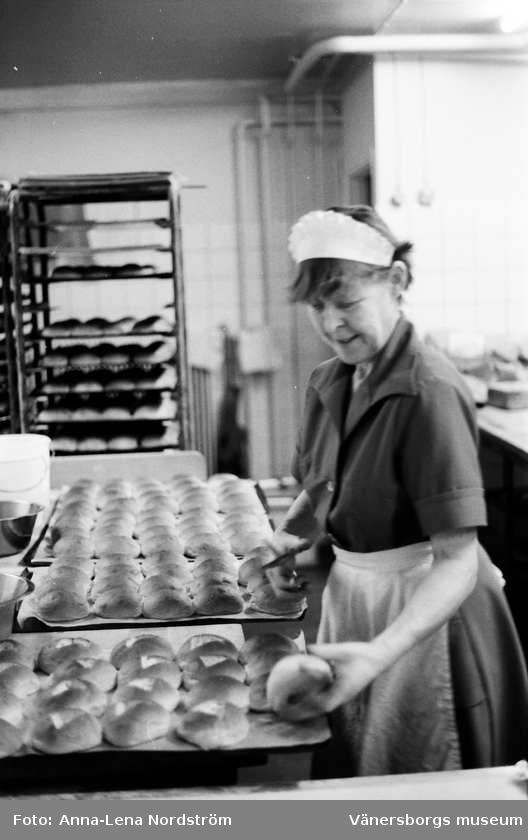
Icing sugar
Let’s get this out of the way.
In my book, a dusting of icing sugar is not optional.
If you feel differently, I don’t think we can be friends.
Visiting the café Sture-Katten in Stockholm in the beginning of January last year, I noticed that their semlor lacked icing sugar on top. Without their protective sprinkling of white, they looked self-conscious and awkward. Naked semlor — the horror! I’ll try to erase the image from my mind and call it a pre-season error.
The easiest way to get a thin, even dusting is to use a small sieve or a tea ball.

Serving your semlor
Now, for the serving. Either you serve it kingslayer-style with warm milk, or as it is.
Historically, semlor have been classified as soup, with the milk often flavored with sugar, cinnamon, and yolks. In 1801, Anna Maria Rückersköld suggests flavoring the milk with grated almond, rose water, sugar, cinnamon, and lemon peel, then whisking it with a couple of yolks. Sugar and cinnamon or vanilla would be the most common versions today if you want to try.

How to make a classic Swedish semla
Adapted from Bonniers kokbok — makes about 18 semlor.
Buns:
25 gr (0,8 ounces) fresh yeast
3 dl (1 1/3 cups) milk
about 9 dl (3 3/4 cups) wheat flour
1 1/2 tsp baking soda (can be omitted)
1 pinch salt
3/4 dl (1/4) cup sugar
1 egg
up to 1 tbsp freshly ground cardamom (if you don’t like a strong cardamom flavor, stick to 2 tsp or omit)
75 gr (2 2/3 ounces) butter, room-temperature
egg, for brushing
Filling:
2 dl (3/4 cups) almonds
1 1/2 dl (2/3 cups) sugar
milk or cream
optional but recommended: cardamom and bitter almond
Assembly:
3 dl (1 1/5 cups) whipping cream
icing sugar, for dusting
The buns
- Heat the milk in a saucepan until it is lukewarm. Crumble the yeast into the bowl of a food processor, and stir it with some of the milk to dissolve it. Add the rest of the milk.
- Mix most of the flour with salt, baking soda, sugar, and cardamom. Add the flour mix, the egg and the butter to the food processor with the milk and yeast, and let it run for around 10 minutes or until the dough is elastic. Check if you need to add more flour — the dough should be somewhat sticky but not runny.
- Cover the bowl with a towel and let it rest for around 40 minutes, or until it has doubled in size.
- Get the dough out onto a flat and clean surface. Divide it into golf ball sized parts (ca 50 grams each). Shape the bun by pressing it into the surface with a flat hand and making cirkular motions, gradually cupping your hand around the dough.
- Place the buns on a baking sheet on a baking tray under a towel for another 30 minutes, or until they have increased about 30% in size. Set the oven to 225°C (435°F).
- Brush the buns with a gently whisked egg. Bake on the middle rack of the oven for around 8-10 minutes or until the buns are golden and baked through. Leave them to cool on a rack.
The filling
- Cut a triangular lid off the bun using a small sharp knife. Hollow out the bun with your finger or a teaspoon and put the crumbs in a bowl.
- Blitz almonds and sugar together in a food processor until finely ground. Add cardamom and grated bitter almond to taste.
- Add the almond and sugar to the crumbs and mix them together with some cream or milk.
Assembly
- Whip the cream. You know your whipped cream taste better than I do, but go for a hard-whipped rather than softly whipped or the lid will try to escape. Pipe or spoon it on top of the buns.
- Put the lids back on, press them lightly into the cream, and dust some icing sugar on top.
- Ta-dah! Serve as your semlor as they are or with hot milk, possibly flavored with sugar and cinnamon. Semlor are best the day they are made, or the cream will start to look at bit sad.
Suggestions
If you don’t want to use all of the buns at the same time, you can either freeze them after they have proved on the baking sheet and let them thaw before baking, or freeze them as soon as they have cooled from the oven.



This article is a complete breath of fresh air! Funny as well as contentful. Looking forward to see what comes up next!
Thank you for this
Gosh, wish I had seen this before my yearly pre-lenten baking. This year’s batch of semlor was uninspired at best. Well, something to look forward to for next year I guess!
Greta post! I’ve never Read about the hostorical evolution of semla in this detaildd step-by-step way. Keep Up THE Good job!
Thank you so much, Max! I’ve seen some weird versions so I look forward to adding more to the list — including non-vegetarian ones… 🙂
I love to make (and eat!) semlor every year but had no idea of all the previous historical versions, so I greatly enjoyed this article. Just made this year’s batch using your recipe and they came out the best of any of my attempts <3
Kate, thank you so much — I’ve become a bit obsessed with finding historical versions… So happy to hear that your semlor were a success!
thank you so much for writing this article! – it is the best one i’ve read so far and packed with so much info! as a newcomer in Stockholm i was trying to find out if the first version of the semla ( the 1737 version), was cardamom already added as a flavoring spice then? since cardamom is not a native spice it would be an expensive spice to add into buns, thus making it luxurious and a real treat?
Hej May, thank you for your comment! And what an interesting question.
You’re right — cardamom would have been an expensive spice. According to ambitious Swedish thesaurus SAOB, cardamom starts to pop up in Swedish records during the 16th century. From the sources I’ve seen from the 17th and 18th century, spices were used quite differently than today. They were considered medicinal and were also a way to show off your wealth. Some of the simpler recipes in the Egerin cookbook might be possible for people of different societal classes, but many were not. For example, farmers would generally have rustic porridge and breads as staples in their diet. On the other hand, finely ground sugar, imported fruits and exotic spices were definitely for the rich.
Susanna Egerin’s cookbook from 1737 has similar two recipes for filled semlor. Neither of them contains cardamom. Like most of the other recipes from the 17th and 18th centuries I’ve seen so far, the Egerin recipes start by making semlor but assumes you already have some. It is worth noting that in this time, “semla” was the word for a plain wheat bun rather than for today’s sweet creation. Meaning, the bun from the 1737 recipe most likely was neither sweet nor scented with cardamom.
However, even if Egerin didn’t use cardamom in any of these two recipes, it was still a popular spice for rich people at the time, although cinnamon seems to have been even more common.
Does this answer your question? I’m starting to think I’ll have to write something about spices soon…